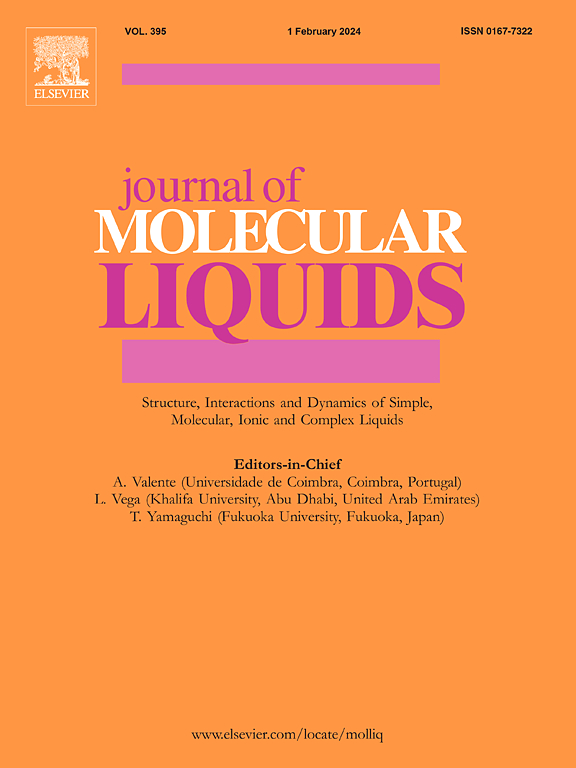对茴香胺基离子液体的合成与抗菌研究:实验、DFT计算与分子对接
IF 5.3
2区 化学
Q2 CHEMISTRY, PHYSICAL
引用次数: 0
摘要
由于离子液体缺乏生物降解能力,大多数研究都集中在深共晶溶剂上。由于各种阳离子和阴离子组合具有抗菌、生物和化学特性,这些液体盐成为挥发性有机溶剂的有前途的替代溶剂。随着越来越多的il被不断地合成或合成,而它们的性质还没有得到充分的评价,人们不断地评价il的重要性和降解性,特别是在工业应用方面。本文合成了乙酸对茴香肼[p-anis][OAc]、三氟甲磺酸对茴香肼[p-anis][OTf]和硝酸对茴香肼[p-anis][NO3]等一系列对茴香肼基il,并对其进行了表征和抑菌效果评价。热重分析(TGA)和差示扫描比色法(DSC)的热图表明[p-anis][OTf]是所测溶剂中最热稳定的。利用Hammett酸碱度函数估算的ILs酸度水平显示Ho值在4.12 ~ 5.17之间。采用琼脂孔扩散法对选定的革兰氏阳性菌和革兰氏阴性菌进行药敏试验,评价化合物的抑菌力,发现受试菌的药敏程度不同。芽孢杆菌和大肠杆菌对[p-anis][NO3]表现出中~强的敏感性。利用B3LYP/ 6-311 + G的密度泛函理论(DFT)分析揭示了电子性质,包括优化能量、偶极矩和HOMO-LUMO能级,这些属性用于推导化学反应性描述符。HOMO-LUMO间隙和相关参数突出了离子液体的稳定性和反应性,其中[p-Anis][NO3]表现出最高的预测反应性。对大肠杆菌(PDB ID: 1KZN)和铜绿假单胞菌(PDB ID: 6P8U)的分子对接研究显示出显著的结合亲和力。[p-Anis][OAc]与1KZN的结合亲和力最高(−6.7 kcal/mol),而[p-Anis][OTf]与6P8U的相互作用最强(−7.6 kcal/mol)。本文章由计算机程序翻译,如有差异,请以英文原文为准。
Synthesis and antibacterial studies of p-anisidinium-based ionic liquids: Experimental, DFT calculations and molecular docking
Most research studies focus on deep eutectic solvents due to the lack of biodegradation of ionic liquids (ILs). Given their antimicrobial, biological and chemical properties that result from various cation and anion combinations, these liquid salts emerged as promising and alternative solvents for volatile organic solvents. As more of ILs are continuously being synthesized or metathesized, and with their properties not fully evaluated, the importance and degradation of ILs is continuously being evaluated, especially for industrial applications. Herein, a series of p-anisidinium-based ILs including p-anisidinium acetate [p-anis][OAc], p-anisidinium trifluoromethanesulfonate [p-anis][OTf] and p-anisidinium nitrate [p-anis][NO3] were synthesized, characterized and evaluated for antibacterial potencies. The obtained thermograms from both thermogravimetric analysis (TGA) and differential scanning colorimetry (DSC) illustrated [p-anis][OTf] as the most thermally stable amongst the examined solvents. The acidity levels of the ILs estimated using Hammett's acidity function revealed Ho values in the range of 4.12 to 5.17. Antibacterial potency of the compounds was evaluated using the microbial susceptibility testing against selected Gram-positive and Gram-negative bacteria using agar well diffusion method and revealed diverse degrees of susceptibility of the test organisms. Bacillus and E. coli bacterial strains showed moderate to strong susceptibility against [p-anis][NO3]. Density Functional Theory (DFT) analysis using B3LYP/6–311 + G revealed insight into the electronic properties, including optimization energies, dipole moments, and HOMO-LUMO energy levels, which were used to derive chemical reactivity descriptors. The HOMO-LUMO gap and related parameters highlighted the stability and reactivity of the ionic liquids, with [p-Anis][NO3] exhibiting the highest predicted reactivity. Molecular docking studies against Escherichia coli (PDB ID: 1KZN) and Pseudomonas aeruginosa (PDB ID: 6P8U) revealed notable binding affinities. [p-Anis][OAc] showed the highest binding affinity with 1KZN (−6.7 kcal/mol), while [p-Anis][OTf] had the strongest interaction with 6P8U (−7.6 kcal/mol).
求助全文
通过发布文献求助,成功后即可免费获取论文全文。
去求助
来源期刊

Journal of Molecular Liquids
化学-物理:原子、分子和化学物理
CiteScore
10.30
自引率
16.70%
发文量
2597
审稿时长
78 days
期刊介绍:
The journal includes papers in the following areas:
– Simple organic liquids and mixtures
– Ionic liquids
– Surfactant solutions (including micelles and vesicles) and liquid interfaces
– Colloidal solutions and nanoparticles
– Thermotropic and lyotropic liquid crystals
– Ferrofluids
– Water, aqueous solutions and other hydrogen-bonded liquids
– Lubricants, polymer solutions and melts
– Molten metals and salts
– Phase transitions and critical phenomena in liquids and confined fluids
– Self assembly in complex liquids.– Biomolecules in solution
The emphasis is on the molecular (or microscopic) understanding of particular liquids or liquid systems, especially concerning structure, dynamics and intermolecular forces. The experimental techniques used may include:
– Conventional spectroscopy (mid-IR and far-IR, Raman, NMR, etc.)
– Non-linear optics and time resolved spectroscopy (psec, fsec, asec, ISRS, etc.)
– Light scattering (Rayleigh, Brillouin, PCS, etc.)
– Dielectric relaxation
– X-ray and neutron scattering and diffraction.
Experimental studies, computer simulations (MD or MC) and analytical theory will be considered for publication; papers just reporting experimental results that do not contribute to the understanding of the fundamentals of molecular and ionic liquids will not be accepted. Only papers of a non-routine nature and advancing the field will be considered for publication.
 求助内容:
求助内容: 应助结果提醒方式:
应助结果提醒方式:


